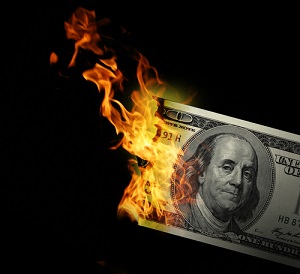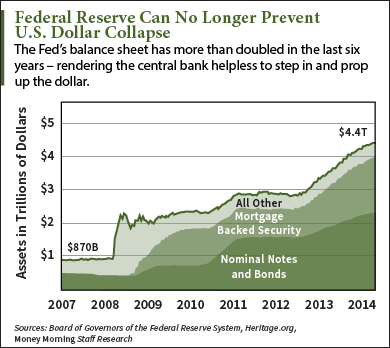 It is a common misconception that the Federal Reserve can protect against a U.S. dollar collapse.
It is a common misconception that the Federal Reserve can protect against a U.S. dollar collapse.
In fact, there is no "safety blanket" for our currency.
What's worse is Fed policies actually hurt U.S. dollar value.
You see, the Fed was formed to provide elasticity to the dollar. The Fed can inject stimulus when the economy flags, or remove it when the economy overheats. In times of economic crisis, the Fed should hypothetically be able to prop up the dollar.
But take a look at the most recent crisis - the 2008-2009 stock market crash.
In November 2008, under former chair Ben Bernanke, the Fed began printing money - aka buying government securities - to "save" the economy. This bond buying would presumably create economic value. The goal was for new money to swell banks' reserves, encouraging them to make more loans. Increased lending would boost investment and stimulate growth.
So through a policy called quantitative easing, the central bank bought $4.5 trillion in Treasury securities, mortgage-backed securities, and other assets until QE was halted in October 2014.
But the Fed's QE didn't have the intended effect.
As a result of QE, the Fed's balance sheet has increased more than fivefold in the last seven years. It owned more than $4.5 trillion in assets as of March 2015, compared to $870 billion in 2008.

Instead, all this bond buying has had one massive consequence: The Federal Reserve devalued the U.S. dollar.
Just take a look at salaries. According to the U.S. Census Bureau, the median income of male workers in 2010 was $32,137 while the median income of male workers in 1968 was $5,980. On the surface this looks good. It's a 437.4% increase over 42 years - or an average income gain of 10.41% a year, over the same time period.
However, if you run the numbers the other way, using 2010 dollars, a very different picture emerges...
Median-earning male workers actually have less purchasing power today than they did 42 years ago ($32,844 vs. $32,137). Every 1913 dollar is now worth $0.04. Goods and services that cost a dollar back then now will set you back $21.
[epom key="ddec3ef33420ef7c9964a4695c349764" redirect="" sourceid="" imported="false"]
In fact, every year you have a paycheck that doesn't go up, you're actually getting a pay cut.
Former congressman Ron Paul famously wrote about the Fed's ever-multiplying balance sheet - and how it has destroyed U.S. dollar value - in his Sept. 16, 2009 book End the Fed.
"The Fed is using all its power to drive the monetary base to unprecedented heights, creating trillions in new money out of thin air. From April 2008 to April 2009, the adjusted monetary base shot up from $856 billion to an unbelievable $1.749 trillion. Was there any new wealth created? New production? No. It's as if we still believe that money can be grown on trees, and we don't stop to realize that if it did grow on trees, it would take on the value of leaves in the fall, to be either mulched or bagged and put in a landfill. That is to say, it would be worthless."
The reality is, neither the Fed - nor any safety net - is in place to prevent a U.S. dollar collapse. What makes that fact more disturbing is that this is only of five dangerous catalysts that currently threaten to bring down the dollar. Click here to find out what these other catalysts are - and what will happen after they are all triggered...
Follow us on Twitter @moneymorning


